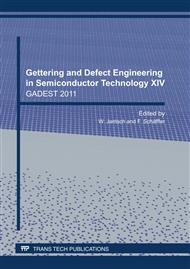[1]
V.G. Litovchenko, A.A. Efremov, B.N. Romanyuk, V.P. Melnik and C. Claeys. Use of gettering and defect induced processes in ultra-thin buried oxide synthesis. Solid State Phenomena, 1997, V. 57-58, pp.97-102.
DOI: 10.4028/www.scientific.net/ssp.57-58.97
Google Scholar
[2]
N.I. Klyui, V.G. Litovchenko, B.N. Romanyuk, V.P. Melnik, V.G. Popov, Extended Abstracts, Spring meeting, San Francisco, California, 1994, May 22-27, V. 94-1, p.876.
Google Scholar
[3]
Sandip Tiwari, Farhan Rana, Hussein Hanafi, et al. A silicon nanocrystals based memory. Appl. Phys. Lett., 1996, 68(10), 1377-1379.
DOI: 10.1063/1.116085
Google Scholar
[4]
B.N. Romanyuk, V.P. Melnik, V.G. Popov, I.M. Khatsevich, A. S. Oberemok. Influence of low-temperature annealing on the photoluminescence of silicon nanocluster structures. Simiconductors, 2010, 44 (4), 533-537.
DOI: 10.1134/s1063782610040184
Google Scholar
[5]
T. Inokuma, Y. Wakayama, T. Muramoto, et al. Optical properties of Si clusters and Si nanocrystallites in high-temperature annealed SiOx films. Journal of Applied Physics. 1998, V. 83, pp.2228-2234.
DOI: 10.1063/1.366961
Google Scholar
[6]
A. Romanyuk, V. Melnik, Ya. Olikh, J. Biskupek, U. Kaiser, M. Feneberg, K. Thonke, P. Oelhafen. Light emission from nanocrystalline silicon clusters embeded in silicon dioxide: role of the suboxide states. Journal of Luminescence, 2010, 130, 87.
DOI: 10.1016/j.jlumin.2009.07.021
Google Scholar
[7]
T. Shimizu-Iwayama et al Optical properties of silicon nanoclusters fabricated by ion implantation, / J. Appl. Phys., 1998, v. 83, №11, pp.6018-6022.
DOI: 10.1063/1.367469
Google Scholar
[8]
A. Nejim, Y. Li, C.D. Marsh, P. L. F. Hemment, R. J. Chater, J. A. Kilner, and G. R. Booker. Direct formation of device worthy thin film SIMOX structures by low energy oxygen implantation. Nuclear Instr. & Methods in Physics Res., 1993, B80/81, 822-826.
DOI: 10.1016/0168-583x(93)90690-8
Google Scholar
[9]
J. Vanhellemont and C. Claeys. A theoretical study of the critical radius of precipitates and its application to silicon oxide in silicon. J. Appl. Phys. 1987. 62, 3960.
DOI: 10.1063/1.339194
Google Scholar
[10]
C. Claeys and J. Vanhellemont, in Proc. 2nd Gettering and Defect Engineering in the Semiconductor Technology, GADEST-87, ed. H. Richter, p.3.
Google Scholar
[11]
A. Sarikov, I. Lisovskyy, V. Litovchenko, M. Vitovich, S. Zlobin, et al. Mechanisms of oxygen precipitation in Cz-Si wafers subjected to rapid thermal anneals. Journal of the Electrochemical Society, 2011, V. 158 (8), pp.772-777.
DOI: 10.1149/1.3594724
Google Scholar


